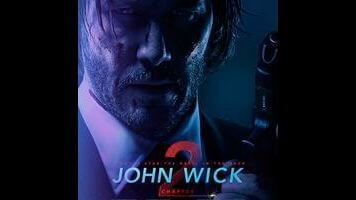Chapter 2 gives John Wick an irresistibly surreal follow-up

David Leitch and Chad Stahelski’s John Wick, the Abominable Dr. Phibes of American action movies, cast Keanu Reeves as a retired hitman out to avenge the death of his dog—a delicious reductio ad absurdum of action-revenge scenarios. The Stahelski-directed sequel, John Wick: Chapter 2, ups the conceptual abstraction, sending the limb-snapping, pistol-toting hero on a symbolic journey through the afterlife, from Roman catacombs to a secret kingdom of the New York City homeless and a delirious museum gala. Lavishly expanding on the first film’s comic-book-esque internal mythology and its sense of the absurd, it’s less of a pure genre movie than its predecessor—more gothic, more narratively stylized, its superlative stuntwork sometimes taking a back seat to visual gags and vignettes of deadpan comedy.
One of the riskier gambits of Derek Kolstad’s script is a first act that is largely action-less, apart from a pre-credits set-piece. It’s a corker: a deranged demolition derby in a chop shop, where Wick has come to recover his beloved ’69 Mustang coupe, stolen by a puppy-killing Russian mob brat in the first film. Our affectless avenger’s second attempt at retirement (complete with a new dog) is short-lived. Santino D’Antonio (Riccardo Scamarcio), a member of the Neapolitan Camorra, arrives on the doorstep of Wick’s perfect modernist house to collect on a blood debt that the legendary contract killer agreed to as a condition of leaving the business to lead a quiet life with his late wife. D’Antonio wants Wick to assassinate his sister so that he can take her place at an international council of criminal syndicates, and he won’t take “no” for an answer.
The original ran with an irresistible premise: the killing machine set on a rampage by the death of a pet. Chapter 2’s plotting lacks the first film’s domino-effect momentum; it’s a movie of interludes, the most memorable being Wick’s trip into the domain of the king of the panhandlers (Reeves’ Matrix co-star Laurence Fishburne), who nonchalantly changes out of his rags into a silk bathrobe. Instead, the movie’s given shape by the central metaphor of the secret criminal underworld as a mythic land of the dead. The gold bullion that is the currency of choice in the Wick-verse realizes its Plutonic meaning here, as does the name of Charon (Lance Reddick), the concierge of the Continental, the boutique hotel that only caters to assassins. Once again, Reeves’ blankness, always in stark contrast to the supporting cast, becomes the character: He is dead inside.
The action itself is entertainingly surreal. Gunmen take suppressed shots at each other unnoticed through a crowd, and blood splatters and brain matter paint the walls of a gallery like a Jackson Pollock canvas; in the dazzling climax, an art installation of rotating mirrored panels transforms into a funhouse of fate and violence. Wick has become an Orpheus figure, with killing as his art. He punches lit cigarettes straight into henchmen’s mouths and pins assailants down with the barrel of his shotgun while he reloads for a point-blank shot to the chest. Blurring the line between the very literal and the completely metaphorical, almost every set is either subterranean or reflective: a tunnel, a subway car, a ruin, a bathroom hung with huge mirrors.
In spirit, it’s almost closer to John Hyams’ Universal Soldier: Day Of Reckoning, which deformed a direct-to-video franchise into a series of art-horror homages. As the first John Wick made overt nods to the cool French noirs of Jean-Pierre Melville, this one seems to reference the genre’s offbeat, hip derivatives, including Jim Jarmusch’s Ghost Dog: The Way Of The Samurai and The Limits Of Control and Alan Rudolph’s Trouble In Mind. Strahelski—an ex-stuntman, like his former co-director Leitch—carries over the first film’s flashy kinetic direction into more stylized and absurdist territory, staging close-quarters shoot-outs in a concert full of mobsters in outrageous new wave attire and interrupting a fist fight of They Live proportions with a seemingly endless tumble down multiple flights of stairs. What an exquisitely strange thing.